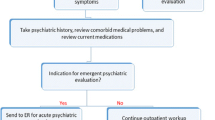Abstract
Depressive symptoms in older adults are common, but the minority of elderly meet criteria for major depressive disorder. This has led to confusion regarding the recognition of diagnosis, approach to treatment, and monitoring of outcomes in this needy population. Few depressed older adults are willing to seek treatment from psychiatrists or mental health specialists. Treatment approaches to the depressive spectrum of disorders in late life, which encompasses major and minor depressive disorder, dysthymic disorder, and mood disorders related to medical conditions, must include evidence-based algorithms that can be delivered in a variety of health care settings. Several recent multisite trials have advanced the use of collaborative care models and the systematic stepwise approach to the treatment of depression and anxiety states in older adults. This offers the ability to provide effective treatment of depression for older adults, consistent with current guidelines, in primary care and specialized health care settings.
Similar content being viewed by others
References and Recommended Reading
Palsson S, Skoog I: The epidemiology of affective disorders in the elderly: a review. Int Clin Psychopharmacol 1997, 12(Suppl 2):S2-S13.
Steffens DC, Skoog I, Norton MC, et al.: Prevalence of depression and its treatment in an elderly population: the Cache County study. Arch Gen Psychiatry 2000, 57:601–607.
Blazer D: Depression in late-life: review and commentary. J Gerontol Med Sci 2003, 58A:249–265.
American Psychiatric Association Work On Major Depressive Disorder. Practice guideline for the treatment of patients with major depressive disorder (revisions). Am J Psychiatry 2000, 157(Suppl 4):1–45.
Callahan CM, Hui SL, Nieanaber NA, et al.: Longitudinal study of depression and health service use among elderly primary care patients. J Am Geriatr Soc 1994, 42:833–838.
Katon WJ, Lin E, Russo J, Unutzer J: Increased medical costs of a population-based sample of depressed elderly patients. Arch Gen Psychiatry 2003, 60:897–903.
Schneider LS, Nelson JC, Clary CM, et al.: An 8-week multicenter, parallel-group, double-blind, placebo-controlled study of sertraline in elderly outpatients with major depression. Am J Psychiatry 2003, 160:1277–1285.
Lavretsky H, Kumar A: Clinically significant non-major depression. Am J Geriatr Psychiatry 2002, 10:239–255.
Mossey J, Knott K, Higgins M, et al.: Effectiveness of a psychosocial intervention, interpersonal counseling, for subdysthymic depression in medically ill elderly. J Gerontol Med Sci 1996, 51:M172-M178.
Singh N, Clements KM, Fiatorone MA: A randomized, controlled trial of progressive resistance training in depressed elders. J Gerontol Med Sci 1997, 52:M27-M35.
Williams J, Barrett J, Oxman T, et al.: Treatment of dysthymia and minor depression in older adults. JAMA 2000, 284:1519–1526.
Oxman TE, Sengupta A: Treatment of minor depression. Am J Geriatr Psychiatry 2002, 10:256–264.
Thase ME, Fava M, Halbreich U, et al.: A placebo-controlled, randomized clinical trial comparing sertraline and imipramine for the treatment of dysthymia. Arch Gen Psychiatry 1996, 53:777–784.
Kocsis JH, Zisook S, Davidson J, et al.: Double-blind comparison of sertraline, imipramine, and placebo in the treatment of dysthymia: psychosocial outcomes. Am J Psychiatry 1997, 154:390–395.
Finkel SI, Richter EM, Clary CM: Comparative efficacy and safety of sertraline versus nortriptyline in major depression in patients 70 and older. Int Psychogeriatr 1999, 11:85–99.
Finkel SI, Richter EM, Clary CM, Batzar E: Comparative efficacy of sertraline versus fluoxetine in patients age 70 or over with major depression. Am J Geriatr Psychiatry 1999, 7:221–227.
Schoevers RA, Beekman AT, Deeg DJ, et al.: The natural history of late-life depression: results from the Amsterdam Study of the Elderly (AMSTEL). J Affect Disord 2003, 76:5–14.
Frank E, Kupfer DJ: Progress in the therapy of mood disorders: scientific support. Am J Psychiatry 2003, 160:1207–1208.
Mulsant BH, Alexopoulos GS, Reynolds CF Jr: Pharmacologic treatment of older primary care patients: the PROSPECT algorithm. Int J Geriatr Psychiatry 2001, 16:585–592.
Alexopoulos GS, Katz IR, Reynolds CF III, et al.: The expert consensus guideline series: pharmacotherapy of depressive disorders in older patients. Postgrad Med 2001, Special Report (October):5–86.
Unutzer J, Katon W, Callahan CM, et al.: Collaborative care management of late-life depression in the primary care setting: a randomized controlled trial. JAMA 2002, 288:2836–2845.
Steffens DC, McQuiod DR, Krishnan RR: The Duke Somatic Algorithm for Geriatric Depression (STAGED) approached. Psychopharmacol Bull 2002, 2:58–68.
Fava M, Rush AJ, Trivedi MH: Background and rationale for the Sequenced Treatment Alternatives to Relieve Depression (STAR*D study). Psychiatr Clin North Am 2003, 26:457–494.
Mather AS, Rodriguez C, Guthrie MF, et al.: Effects of exercise on depressive symptoms in older adults with poorly responsive depressive disorder: randomised controlled trial. Br J Psychiatry 2002, 180:411–415.
Moore KA, Blumenthal JA: Exercise training as an alternative treatment for depression among older adults. Altern Ther Health Med 1998, 4:48–56.
Sumaya IC, Rienzi BM, Deegan JF 2nd, Moss DE: Bright light treatment decreases depression in institutionalized older adults: a placebo-controlled crossover study. J Gerontol Biol Sci Med Sci 2001, 56:M356-M360.
Katz IR, Simpson GM, Curlik SM, et al.: Pharmacologic treatment of major depression for elderly persons in residential care settings. J Clin Psychiatry 1990, 51(Suppl B):41–48.
Cohn CK, Shrivastava R, Mendels J, et al.: Double-blind, multicenter comparison of sertraline and amitriptyline in elderly depressed patients. J Clin Psychiatry 1990, 51(Suppl B):28–33.
Schone W, Ludwig M: A double-blind study of paroxetine compared with fluoxetine in geriatric patients with major depression. J Clin Psychopharmacology 1993, 13(6 Suppl 2):34S-39S.
Roose SP: Treatment of depression in the “old old”: a randomized double-blind, placebo-controlled trial of citalopram in patients at least 75 years old. Paper presented at the 15th annual meeting of the American Association for Geriatric Psychiatry. Orlando, FL: February 24–27, 2002.
Author information
Authors and Affiliations
Rights and permissions
About this article
Cite this article
Lantz, M.S. Advances in the treatment of depression in older adults. Curr psych & therapeutics rep 2, 7–12 (2004). https://doi.org/10.1007/s11922-004-0001-1
Issue Date:
DOI: https://doi.org/10.1007/s11922-004-0001-1




